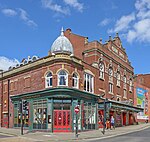Thornes Park
Garden stubsParks and commons in WakefieldUse British English from August 2020West Yorkshire geography stubs

Thornes Park is a large public park situated close to the centre of Wakefield, West Yorkshire, England. Along with Clarence Park and Holmfield Park it forms a large parkland to the south west of the city. The park hosts a model railway, formal gardens, a lake, an indoor leisure centre and an athletics track. The park also has 60 hectares of open spaces and a two-mile circular walkway around the park. A mound lies in the centre of the park, once part of an old motte-and-bailey castle, which offers views across the city.
Excerpt from the Wikipedia article Thornes Park (License: CC BY-SA 3.0, Authors, Images).Thornes Park
Lawefield Lane, Wakefield Thornes
Geographical coordinates (GPS) Address Nearby Places Show on map
Geographical coordinates (GPS)
| Latitude | Longitude |
|---|---|
| N 53.6725 ° | E -1.51 ° |
Address
Lawefield Lane
WF2 8SY Wakefield, Thornes
England, United Kingdom
Open on Google Maps











